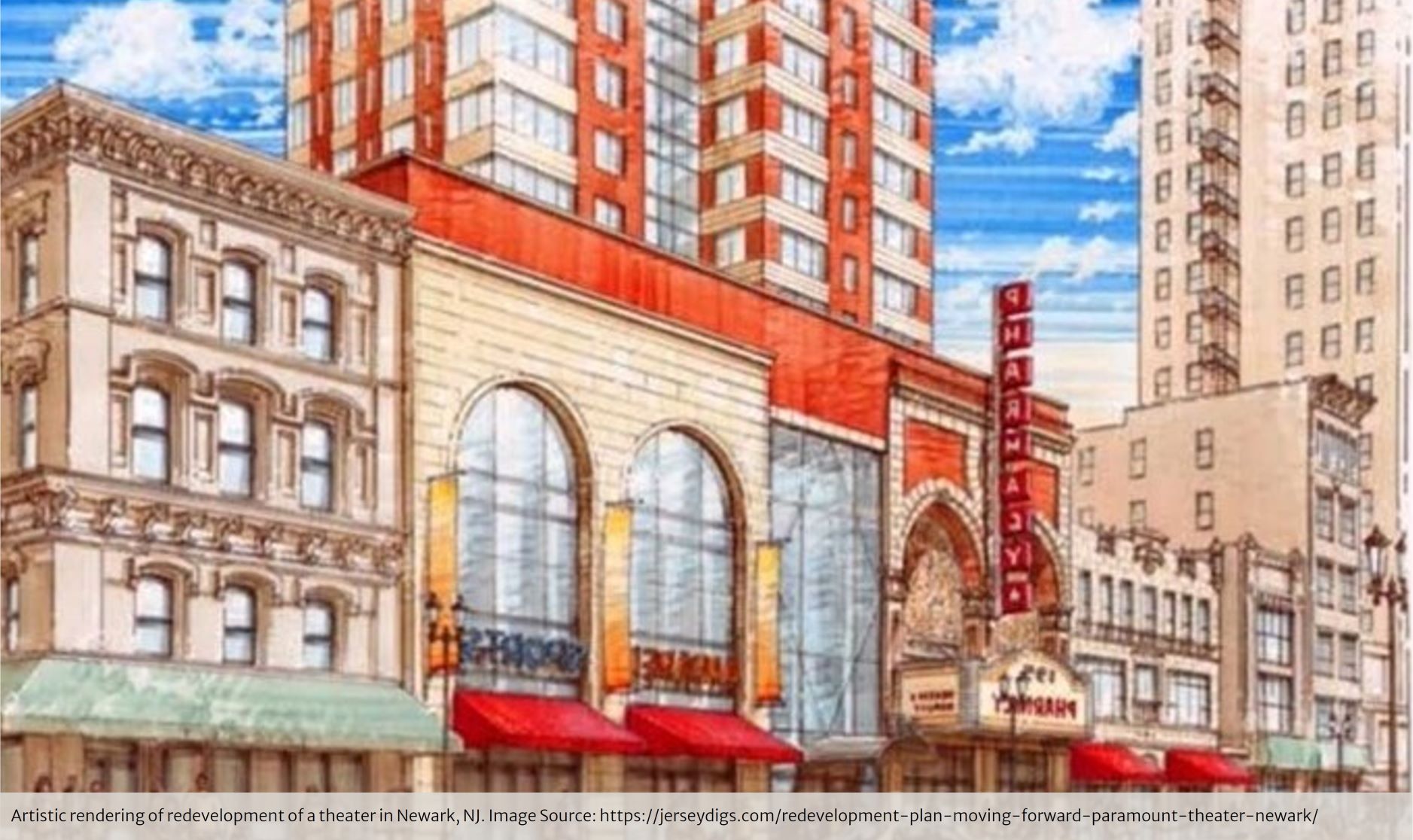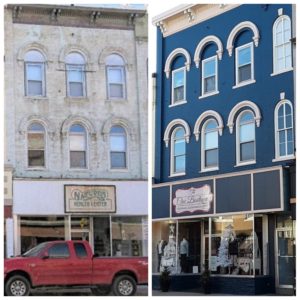Indianola, IA, is known for the National Balloon Classic, Simpson College, and the seat of county government. Its small-town charm and proximity to the airport frequently attracted Presidential candidates during the Iowa caucuses. When I was growing up there in the 1980s, Indianola also boasted of another gem – a JCPenney’s downtown. That is until they announced they were closing. I distinctly remember my mother dragging me on an emergency shopping trip to stock up on pantyhose.
Regional malls and transportation corridors built to avoid city centers attracted many downtown tenants like our beloved JCPenney’s away from downtown in the 1970s and 1980s. But, after a period of decline, evidence suggests that many metro downtowns across the country were thriving. That is, until last March when the winds of change shifted. Indeed, a dark cloud is hovering over the central city[1]. However, I believe we are witnessing the micro-evolution of downtown yet again. Adaptability seems to be the name of the game for businesses and local governments.
Why Downtowns Must Be Adaptable
First, employment centers in downtowns facilitate talent attraction, support collaboration, reduce time spent traveling to customers and business partners, and can help companies improve their triple bottom line. In fact, before 2020 talent attraction was the topic of the day and Millennials are now the largest generational segment of the American workforce.[2] This segment of the population tends to prefer mixed-use urban “live, work, play” environments at a higher rate than other generations. Responsible corporate practices are also part of the talent attraction scheme as “Millennials are more likely to care about corporate social responsibility than previous generations, and consider this a determining factor in choosing where to work.”[3]
Second, for residents and visitors “Downtowns concentrate assets, giving locals and those living further away access to densities of jobs, shopping, restaurants, government services, entertainment venues, and more.”[4] Downtowns may be suffering, but they’re not dead and for good reasons.
Adaptable Office Space
Employees working from home have decreased daytime headcounts in downtown offices. Previously averse to the idea of allowing their employees to work from home, employers have become adaptable and have discovered that they can be productive in their home offices. However, productivity isn’t always a company’s top priority. Innovation, collaboration, networking, and mentoring are easier to cultivate in-person. Therefore, the square footage a company leases will need to be based on peak employee headcount rather than average employee headcount. Landlords may need to alter their building footprint to create more flexible amenities for those few times a year that a business would need to occupy spaces for peak employee occupancy.[5]
An adaptable downtown space design will also likely need to allow for touchless entry and exit. For example, traffic flow in and out of communal spaces will limit entering and exiting through the same doorway. Work stations will be spaced to allow for social distancing. Additionally, the use of surfaces and materials that are easily cleaned may need to change. In fact, these changes may become indicators of the post-COVID design era similar to the design characteristics of previous decades like the Le Corbusier concrete heavy facades of the 1960s.[6]
Adaptable Hospitality & Retail
The methods of providing services to guests of hotels, restaurants, and retailers must also be adaptable. For example, stores and restaurants that previously did not offer pick-up, delivery, or online ordering have implemented these services. The impact of these adaptations has been substantial. For instance, tourism dropped nationally by as much as 70% year-over-year in April and rebounded to -5.1% Labor Day weekend.[7] According to a recent report by Dr. Steven Deller, “Firms that have found it more difficult to adapt have been more negatively impacted than those that have adapted.[8]”
Certainly, I experienced this first-hand on a trip with my family last month. As a family of six, we attempt to find hotels near our destination that provide complimentary breakfast. We discovered that rather than the buffet-style breakfast, we would be provided with a brown bag breakfast. Our goodie bags included fruit, pastry, and yogurt. My kids ended up trading their items like candy at Halloween. This may be a temporary service change, but it provided this consumer with the confidence to book another night.
Adaptable Public Space & Transportation
In a blog post my colleague Marisa Mutty posted last May she states, “. . . local governments should proactively (and collaboratively with community business leaders) look at their zoning codes and other rules to determine where they can make temporary or permanent adjustments to accommodate more creative use of space. Local leaders and economic developers should also find ways to streamline the permitting process and even waive or cover fees if possible.[9]” Since then, many communities have permitted restaurants to expand their outdoor dining space to accommodate the social distancing of their patrons. For example, the City of Madison’s Economic Development and Planning Departments have created a Streatery Program. The program allows for restaurants in the city to use outdoor spaces such as private parking lots, public sidewalks, and street parking spaces as outdoor dining spaces.
Mass transportation has been impacted in many ways as well. For the better in some cases for the health of drivers and patrons. The Madison Metro has installed plastic shields to protect bus drivers. I wouldn’t be surprised to find hand sanitizer conveniently located next to the ticket machine in the coming months either. The decrease in ridership and increased costs of facility and vehicle cleaning is hitting transportation budgets hard though. Bus stop schedules may be temporarily adjusted accordingly.[10]
Rural and Suburban Downtowns
The data is less clear about how they have faired over the last several decades. Anecdotally, I can attest to the success of a few that have found their own niche market and appear to be doing quite well. The ones that I can think of off the top of my head have other means of capturing a particular market- an institute of higher education, a haven for artists, or a wealth of natural amenities that attract a steady flow of visitors. The ability to leverage one or more assets is vital.
Conclusion
As the heart of the community, downtowns provide a density of assets including jobs, goods & services, restaurants, and entertainment options. They’ve been evolving for decades due to other market forces and will continue to do so post-COVID-19. Floor-plans, space design, and accessibility to your favorite bus driver are likely here to stay. Changes in the way communities have been experimenting with public spaces like sidewalks and parking spaces may be more or less sticky. But downtowns are not going away. Again, the name of the game is agility.
[1] Renn, A. M. (2020, June 15). The Cloud over the Future of America’s Downtowns. Retrieved September 28, 2020, from https://www.governing.com/community/The-Cloud-over-the-Future-of-Americas-Downtowns.html
[2] Fry, R. (2015, May 11). “Millennials surpass Gen Xers as the largest generation in U.S. labor force.” Pew Research Center. Retrieved May 11, 2015 at http://www.pewresearch.org/fact-tank/2015/05/11/millennials-surpass-gen-xers-as-the-largest-generation-in-u-s-labor-force/.
[3] Anderson, G. (2015). Core Values: Why American Companies are Moving Downtown. Retrieved September 25, 2020, from https://smartgrowthamerica.org/resources/core-values-why-american-companies-are-moving-downtown/
[4] Tomer, Adie and Lara Fishbane. (2020). Big city downtowns are booming, but can their momentum outlast the coronavirus? Retrieved September 28, 2020, from: https://www.brookings.edu/research/big-city-downtowns-are-booming-but-can-their-momentum-outlast-the-coronavirus/
[5] Levy, S. (2020, August 14). The Weekly Take Flex Lives: Reinventing Flexible Offices Amid Disruption. Retrieved September 28, 2020, from https://www.cbre.com/the-weekly-take
[6] Romano, E., Loth, H. T. (2020, September 9). Design with Lasting Impact: Considerations for the Resilient Workplace. Retrieved September 28, 2020, from http://anyflip.com/avei/snic
[7] Barnes, T. E., Holmberg, L. (2020, September 25). COVID-19 Travel Industry Research. Retrieved September 28, 2020, from https://www.ustravel.org/toolkit/covid-19-travel-industry-research
[8] Deller, S. (2020). Impact of COVID-19 on the Wisconsin Economy. WIndicators, Volume 3, Number 4. Pg. 9. Retrieved from: https://economicdevelopment.extension.wisc.edu/articles/windicators-volume-3-number-4-impact-of-covid-19-on-the-wisconsin-economy/
[9] Mutty, M. (2020). What small businesses need now from local government, economic development organizations, and each other. [Blog Post] Retrieved from: https://redevelopment-resources.com/what-small-businesses-need-now-from-local-government-economic-development-organizations-and-each-other/#more-740
[10] Inc., EBP US. (2020). The Impact of the COVID-19 Pandemic on Public Transit Funding Needs in the U.S. Retrieved September 28, 2020, from https://www.apta.com/research-technical-resources/research-reports/






